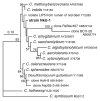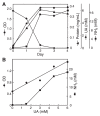Isolation and characterization of anaerobic bacteria for symbiotic recycling of uric acid nitrogen in the gut of various termites
- PMID: 22791052
- PMCID: PMC4036019
- DOI: 10.1264/jsme2.me11325
Isolation and characterization of anaerobic bacteria for symbiotic recycling of uric acid nitrogen in the gut of various termites
Abstract
Recycling of the nitrogenous waste uric acid (UA) of wood-feeding termites by their gut bacteria is one of the significant aspects of symbiosis for the conservation of nitrogen sources. Diverse anaerobic UA-degrading bacteria comprising 16 species were isolated from the gut of eight termite species, and were assigned to Clostridia, Enterobacteriaceae, and low G+C Gram-positive cocci. UA-degrading Clostridia had never been isolated from termite guts. UA-degrading ability was sporadically distributed among phylogenetically various culturable anaerobic bacteria from termite guts. A strain of Clostridium sp., which was commonly isolated from three termite species and represented a probable new species in cluster XIVa of clostridia, utilized UA as a nitrogen source but not as a sole carbon and energy source. This feature is in clear contrast to that of well-studied purinolytic clostridia or previously isolated UA degraders from termite guts, which also utilize UA as a sole carbon and energy source. Ammonia is the major nitrogenous product of UA degradation. Various purines stimulated the growth of this strain when added to an otherwise growth-limiting, nitrogen poor medium. The bacterial species involved the recycling of UA nitrogen in the gut microbial community of termites are more diverse in terms of both taxonomy and nutritional physiology than previously recognized.
Figures


References
-
- Barnes EM, Impey CS. The occurrence and properties of uric acid decomposing anaerobic bacteria in the avian caecum. J Appl Bact. 1974;37:393–409. - PubMed
-
- Bauer S, Tholen A, Overmann J, Brune A. Characterization of abundance and diversity of lactic acid bacteria in the hindgut of wood- and soil-feeding termites by molecular and culture-dependent techniques. Arch Microbiol. 2000;173:126–137. - PubMed
-
- Breznak JA. Ecology of prokaryotic microbes in the guts of wood- and litter-feeding termites. In: Abe T, Bignell DE, Higashi M, editors. Termites: Evolution, Sociality, Symbioses, Ecology. Kluwer Academic Publishers; Dordrecht: 2000. pp. 209–231.
-
- Brune A, Ohkuma M. Role of the termite gut microbiota in symbiotic digestion. In: Bignell DE, Roisin Y, Lo N, editors. Biology of Termites: A Modern Synthesis. Springer; Dordrecht: 2011. pp. 439–475.
-
- Collins MD, Lawson PA, Willems A, et al. The phylogeny of the genus Clostridium: proposal of five new genera and eleven new species combinations. Int J Syst Bacteriol. 1994;44:812–826. - PubMed
Publication types
MeSH terms
Substances
Associated data
- Actions
- Actions
- Actions
- Actions
- Actions
- Actions
- Actions
- Actions
- Actions
- Actions
- Actions
- Actions
- Actions
- Actions
- Actions
- Actions
LinkOut - more resources
Full Text Sources
Molecular Biology Databases
Research Materials

